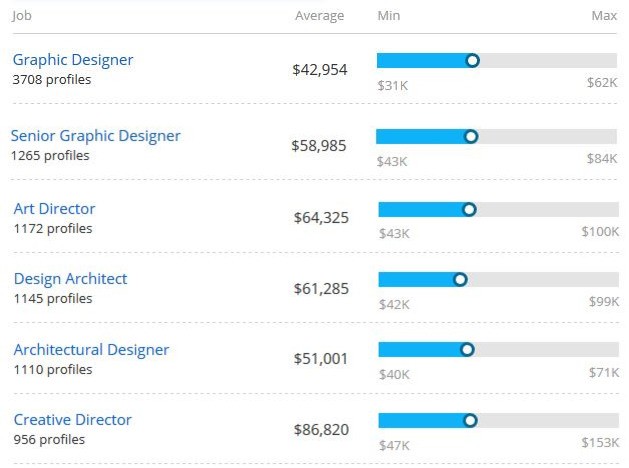How to become a Graphic Designer
This article provides in-depth information into What is a Graphic Designer? What Graphic Designers do? Degrees for Graphic Designers, Steps to become Graphic Designer and much more.
A graphic designer is a creative expert who works on the visual communication for corporations, entertainment industry, the government and nonprofit organizations with the designing of informative designs, layouts, for the purpose of advertisement, brochures, magazines, reports and many more. This guide will help you become a graphic designer in easy steps and in choosing the right degree program for you.
What does a Graphic Designer do ?
A graphic designer may work at an organization or collaborate as teams or work as an independent while specialising at Typography, Desktop Publishing, Branding and Advertising, Web Design, Product Packaging, Book Design, Logos.
The roles of graphic designer include,
-
Develop product design and logo for the organisation
-
Develop layouts and give visual presentation
-
Meet the art directors and other artistic professionals to innovate new ideas
-
Use designing softwares to enhance the image or concept
-
Collaborate with teams and gain unique ideas to come with a final design
-
Get client feedback and implement the final design
Steps for becoming a Graphic Designer
1
Earn A Degree In Graphic Designing
You could choose a bachelor's or associate's degree to gain the necessary skills related to the design, technology, and communication. This includes coursework such as studio art, principles of design, commercial graphics, web design, advertising, and graphics-related computer technology with the knowledge on software such as Adobe Creative Suites.
This not involves a formal education but also hand-on experience with the internship programs and students can choose online courses according to their convenience.
2
Gain Experience From An Internship
An internship program to convert and learn the theoretical concepts into a practical experience. This helps students to work with professionals who can guide and supervise their work. Many colleges offer an internship program to students which helps them build networks and relationships with professionals, and design presentations to develop a portfolio.
3
Create A Portfolio
If you are a graphic designing student pursuing a degree program, you must build a portfolio that is an integral part of the program. A portfolio is a demonstration of work including all the necessary designing skills, graphic software knowledge, effectiveness in communication, and efficiency in work. When you want to get a job, you must submit your portfolio with the resume. Hence you must invest time in creating an effective portfolio to stand out among the applicants.
4
Land On A Job
After building an effective portfolio and gaining skills in the field, you now strive to earn your dream job. After landing on the job you start working on the advancement of your career by being up-to-date on the skills, software, and the latest technologies.
You could also pursue a Master’s degree such as MA or MFA to advance in the theoretical knowledge and creativity in work.
Graphic Designer Degree Levels
Associate
The associate’s degree in graphic arts is a two years course which gives you 65 credits to complete. It contains both the arts and general courses such as design theory and technology, typography, color theory, computer graphics, electronic imaging, and print/digital production. You are also given the option to easily transfer credits to the bachelor's degree and hence this acts as a stepping stone for the four year program.
Digital layouts
-
Fundamentals of typography
-
Corporate and personal branding
-
Printing and printing papers
Objectives
-
Communicate messages in a compelling and memorable way
-
Master different software programs
-
Creating once and publishing everywhere
Color theory
-
The color wheel
-
Color harmony
-
Color Context
Objectives
-
A body of practical guidance to color mixing
-
Visual effects of a specific color combination
-
Develop color schemes
Design fundamentals
-
This course includes the principles of graphic design, the effective communication tools, application of the design elements and working with the image-making and other practices.
Objectives
-
Learn the application and principles of graphic practices
-
Understand the application of lines, colors, textures, shapes, values, and white space in graphic designs
-
Working with the color and shapes to design
Introduction to typography
-
The course helps students to understand the visual form of language and has control over the information it can convey. Students also learn how the letterform can be used in name, brands, logo, or personality.
Objectives
-
Basic skills on the style and fonts on the texts in letterforms.
-
Understand on how the letters can affect the understand of the audience
Bachelors
The bachelor's degree is a four year program that offers 120-180 credits hours to students which include the general education, core courses on graphic arts and electives. It is a program to provide knowledge to students on interactive design, typography, and motion graphics.
Production for Digital and Print Environments
-
Creating design concepts
-
Delivering files using project management protocols
-
Design software
Objectives
-
delivering production-ready graphics
-
Files for print and mobile devices
-
Estimating for Printers
Media Management in Digital Design
-
Coordinate staff
-
Oversee series of processes
-
Design development tools
Objectives
-
Creating and managing visual communications
-
Managing channels with distinct timelines
-
Digital Media Production
Portfolio Development
-
Design and develop a portfolio
-
Present portfolio
-
Clearly discuss skills and abilities
Objectives
-
Compiling previous design work into an effective portfolio
-
Exhibit professional conduct
-
Interact effectively with output bureaus
Masters
The master's degree is a two-year course and chosen by students who want to advance their knowledge in designing and graphic softwares. There are two options for you in the masters degree,
-
Masters of Arts (MA): This is an advanced degree for students offered to specialize in the specific topics. Usually chosen by candidates who are interested in teaching or researching.
-
Masters of Fine Arts (MFA): This is a professional degree for graphic students who prefer to research and explore various fields of graphic technology. A student graduating from MFA uses their portfolio and projects to get higher-earning jobs and communicate with the world or demonstrate the new skills acquired by them.
Artistic Originality
-
signature style
-
skills to express own aesthetics
Objectives
-
Develop own creative expressions
-
The Pros of Pushing Originality
-
Pitfalls of Pushing Originality
Business Acumen
-
Entrepreneurship
-
Effectively navigate business relationships.
-
Pitching and Selling designs
Objectives
-
Skills in sales, marketing, and customer relations
-
Making Mindful Decisions
-
Management Considerations
Motion Graphics
-
CINEMA 4D
-
MoGraph
-
Adobe After Effects
Objectives
-
Creation of entertainment
-
Broadcast, web, and emerging media
-
Elements of motion design
Certificate
Certificate programs differ from degrees in that they consist of fewer courses and may be completed in a relatively short time frame. While they do not offer the broad-based knowledge experience that comes from a full degree program, they offer a concentrated selection of courses which, when taken together, demonstrate expertise in a particular area.
Digital Imaging
-
Digital imaging tools
-
Digitally-manipulated artwork
-
Contemporary art practice
Objectives
-
Creation of photographic images
-
Compression, storage, printing, and display of images
-
Identify and specify different graphics file formats
Web Designing
-
HTML
-
Php
-
CSS
Objectives
-
Understanding production and maintenance of websites
-
Employ fundamental computer theory
-
Select and apply markup languages
Desktop Publishing
-
Drawing Tools
-
Camera Raw
-
Vintage Cloud Photos
Objectives
-
Production of printed matter
-
Manipulate text and graphics
-
Create fliers, brochures, and multiple page documents
Online schools for graphic design:
The online schools in graphic arts may offer degrees in the same names such as the AA, BA, MFA but the courses offered might not be similar to the traditional degrees. This offer affordable private training with flexible study hours according to the convenience of the students
For example, a student is gaining work experience at an internship and enrolled for an online master's degree, the degree is earned simultaneously, hence this benefits students with saving time and money.
Graphic designer salary
According to the BLS 2020, the average salary offered for a graphic designer at the United States is about $74,443 and it ranges between $47,125 to $101,761 which depends on the potentials of the candidate, education, certification, additional skill, amount of experience.
However, the earning of a self-employed graphic designer is estimated to be $20,000 per year.
Job growth
As stated by the BLS, the job growth of a graphic designer is estimated to be increased by 7 percent in the period of 2012 to 2022 but it is lesser compared to the average growth of the job. The employment opportunity is reducing due to the decrease in print media and the development of digital media.
However, the job rates may increase to graphic designers who are skilled in designing using the computer system and web-based graphics may increase up to 35 percent with an additional job opening of 17,400.
| Minumum Credit Score | Apply in as little as | Variable APR | Fixed APR | ||
|---|---|---|---|---|---|
 | Not Available | 15 minutes or less | 2.95 | 4.74 | View disclosures |
 | 620 | 2 minutes | 5.38%-16.99%1 | 4.43%-16.99%1 | View disclosures |
 | Not Available | 15 minutes | 1.13% - 11.23%¹ (with autopay) | 3.50% - 12.60%¹ (with autopay) | View disclosures |
